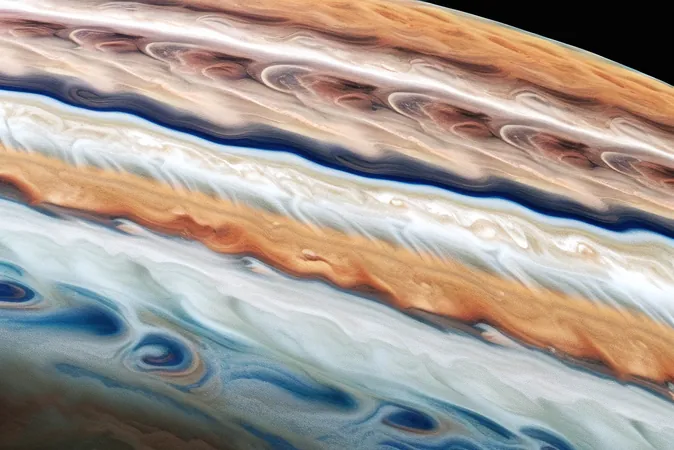
Groundbreaking Discoveries About Jupiter's Clouds Have Astronomers in Awe!
2025-01-08
Author: Ling
Groundbreaking Discoveries About Jupiter's Clouds Have Astronomers in Awe!
Jupiter, known for its mesmerizing bands of clouds and the iconic Great Red Spot, has long been a source of intrigue among astronomy enthusiasts and professionals alike. Recent research initiated by a team of determined citizen scientists has upended traditional beliefs about the planet's cloud composition, suggesting that the well-known clouds might not be primarily composed of ammonia ice, as previously thought.
This pivotal study, now published in the Journal of Geophysical Research – Planets, sheds new light on the intricate workings of Jupiter's cloud layers and atmospheric dynamics. For years, amateur astronomers have closely observed Jupiter, meticulously tracking its ever-changing features through both casual backyard telescopes and sophisticated observatories.
Revolutionary Observations from Citizen Scientists
Notably, Dr. Steven Hill, an amateur astronomer from Colorado, has ushered in this new era of understanding through innovative methods. Utilizing commercial telescopes and specialized colored filters, he meticulously captured images at certain wavelengths to assess ammonia's abundance and the heights of cloud formations. His findings revealed that the clouds are located at depths that are too warm for ammonia ice to form, challenging long-held scientific assumptions.
Building on Dr. Hill's groundwork, Professor Patrick Irwin of the University of Oxford adopted this technique to analyze data from the European Southern Observatory's Very Large Telescope in Chile. The results of their computer simulations indicated that the primary cloud layers extend far deeper than previously believed, leading them to conclude that they are unlikely to be composed of ammonia ice.
“I am astonished that such a simple method is able to probe so deep in the atmosphere and demonstrate so clearly that the main clouds cannot be pure ammonia ice!” exclaimed Professor Irwin. This discovery not only showcases the power of amateur contributions to science but also reveals more about Jupiter's complex weather systems.
A New Era for Citizen Science in Astronomy
The ammonia mapping developed through these advanced photographic techniques enables amateur astronomers to monitor changes in Jupiter's atmosphere, making it more accessible for regular enthusiasts. Researchers note that tracking visible changes, such as the emergence of small storms, is now easier than ever, thanks to the amateur mapping techniques.
John Rogers of the British Astronomical Association emphasized the significance of this approach: “A notable advantage of this technique is its potential for frequent use by amateurs, enabling a direct connection between observable weather changes on Jupiter and variations in ammonia levels.”
The Intriguing Role of Ammonia and Photochemistry
Interestingly, there are instances where strong updrafts on Jupiter can manifest as puffy ammonia ice clouds. Previous missions, including NASA's Galileo and Juno spacecraft, have documented these smaller, bright clouds casting distinct shadows amidst the planet’s otherwise dark atmosphere. Scientists suggest this phenomenon occurs due to rapid uplift that allows ammonia to condense before being broken down by chemical reactions involving sunlight.
Photochemical processes play an essential role in shaping Jupiter's cloud composition. The dynamic interplay of rising ammonia-rich air with sunlight creates smog-like materials, explaining the reddish-brown hues that dominate much of the planet's atmospheric visuals.
Similar Findings on Saturn: A Galactic Connection?
Encouraged by the Jupiter findings, Professor Irwin's team extended their research to Saturn, employing the same filter-based strategy. Their results echoed other studies, including observations made using the James Webb Space Telescope. Remarkably, Saturn’s clouds also appear deeper than the ammonia condensation levels, suggesting parallel atmospheric dynamics and chemical interactions.
These intriguing discoveries reveal striking similarities between the gas giants, hinting at shared atmospheric processes shaped by both rising and sinking air, alongside sunlight-driven chemical reactions.
Implications and Future Research
With these exciting insights, astronomers now have a more effective toolkit to measure and analyze Jupiter’s atmospheric conditions frequently. This approach provides a crucial mechanism for unraveling the mysteries of storms, jet streams, and other atmospheric phenomena over extended periods.
As researchers continue to delve into Jupiter and Saturn's compositions, they aim to correlate their findings with data from spacecraft orbiting these planets. The collaboration between ground-based and space-based observations, bolstered by the vigor of citizen scientists, opens the door to a more profound understanding of these magnificent celestial bodies.
Stay tuned as we witness the unfolding narrative of Jupiter’s clouds and their secrets, and do not miss the chance to keep up with the latest updates in this realm of astronomical adventure!


 Brasil (PT)
Brasil (PT)
 Canada (EN)
Canada (EN)
 Chile (ES)
Chile (ES)
 Česko (CS)
Česko (CS)
 대한민국 (KO)
대한민국 (KO)
 España (ES)
España (ES)
 France (FR)
France (FR)
 Hong Kong (EN)
Hong Kong (EN)
 Italia (IT)
Italia (IT)
 日本 (JA)
日本 (JA)
 Magyarország (HU)
Magyarország (HU)
 Norge (NO)
Norge (NO)
 Polska (PL)
Polska (PL)
 Schweiz (DE)
Schweiz (DE)
 Singapore (EN)
Singapore (EN)
 Sverige (SV)
Sverige (SV)
 Suomi (FI)
Suomi (FI)
 Türkiye (TR)
Türkiye (TR)
 الإمارات العربية المتحدة (AR)
الإمارات العربية المتحدة (AR)